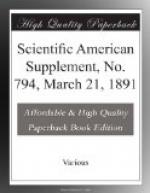It is rather difficult to-day to define what high explosives are, in contradistinction to gunpowder. Thirty years ago we could say that powder was a mechanical mixture and the others were chemical compounds; but of late years this difference has disappeared.
The dynamical difference, however, still remains. Gunpowder in its most efficient form is a slow-burning composition, which exerts a relatively low pressure and continues it for a long time and to a great distance. High explosives, on the contrary, in their most efficient form, are extremely quick-burning substances, which exert an enormous pressure within a limited radius. Ordinary black gunpowder consists of a mechanical mixture of seventy-five per cent. of saltpeter, fifteen per cent of charcoal, and ten per cent. of sulphur. The most important of the high explosives are formed by the action of nitric acid upon organic substances or other hydrocarbons, the compound radical no2 being substituted for a portion of the hydrogen in the substance. The bodies thus formed are in a condition of unstable equilibrium; but if well made from good material, they become stable in their instability, very much like Prince Rupert’s drops, those little glass pellets which endure almost any amount of rough usage; but once cracked, fly into infinitesimal fragments.
The power exerted by these nitro-substitution products is due to the fact that they detonate, i.e., they are instantaneously converted into colorless gas at a very high temperature, and in addition they have almost no solid residue. Nitro-glycerine actually leaves none at all, while gunpowder leaves sixty-eight per cent. The first departure in gunpowder from the old-time constituents of black powder just mentioned was for the purpose of obtaining less pressure and slower combustion than could be produced by mere granulating or caking. This was accomplished by using underburned charcoal, together with sugar and about one and one-half per cent. of water. This is the brown powder most generally used at present and with satisfactory results; but the abstraction of its moisture increases its rapidity of combustion to a dangerous degree, besides which the underburned charcoal is itself unstable.




